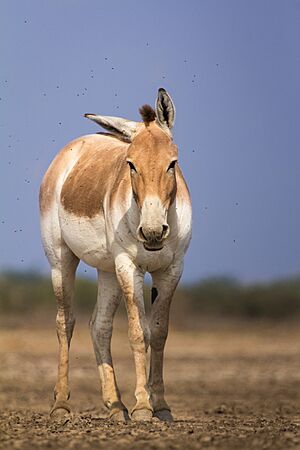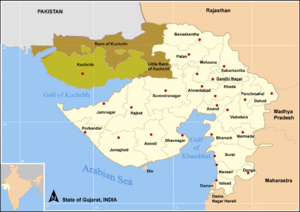Indian wild ass facts for kids
Quick facts for kids Indian wild ass |
|
|---|---|
 |
|
| An Indian wild ass near Ahmedabad, India. | |
| Conservation status | |
| Scientific classification |
|
| Kingdom: | Animalia |
| Phylum: | Chordata |
| Class: | Mammalia |
| Order: | Perissodactyla |
| Family: | Equidae |
| Genus: | Equus |
| Species: | |
| Subspecies: |
E. h. khur
|
| Trinomial name | |
| Equus hemionus khur Lesson, 1827
|
|
 |
|
| Map of Gujarat showing the Little Rann of Kutch and Great Rann of Kutch. | |
| Synonyms | |
|
Equus hemionus indicus |
|
The Indian wild ass (Equus hemionus khur) is also known as the Indian onager. In the local Gujarati language, people call it Ghudkhur or Khur. This animal is a type of subspecies of the onager, and it lives in South Asia.
Currently, the Indian wild ass is listed as Near Threatened by the IUCN. This means it could become endangered in the future if we don't protect it.
In 2009, there were about 4,038 Indian wild asses. By 2014, this number grew to 4,451. As of 2015, the population reached around 4,800.
The population has kept growing! In March 2020, a count showed there were 6,082 Indian wild asses. This is great news for these amazing animals.
Contents
Physical Features
The Indian wild ass looks quite different from the African wild ass. Its coat is usually sandy in color. But it can also be reddish-grey, fawn, or a pale chestnut.
This animal has a dark mane that stands straight up. It runs from the back of its head all along its neck. A dark brown stripe then goes from the mane down its back to its tail.
Where They Live
The Indian wild ass used to live in many places. Its home stretched across western India, southern Pakistan, Afghanistan, and southeastern Iran.
Today, its main home is in the Indian Wild Ass Sanctuary. This sanctuary is in the Little Rann of Kutch in the Gujarat state of India. They are also seen in nearby areas like the Great Rann of Kutch.
You can also find them in districts like Surendranagar, Banaskantha, Mehsana, and other Kutch areas. They love living in salty deserts called rann, dry grasslands, and areas with shrubs.
Spreading Out
The number of Indian wild asses has been growing. They are also starting to spread out from the Little Rann of Kutch. This is where most of them used to live.
Now, they are moving into the Greater Rann of Kutch. They are even going into the nearby state of Rajasthan. This includes villages in the Jalore district that border the Rann of Kutch.
In these new areas, they share their home with other animals. These include chinkaras, striped hyenas, red foxes, desert cats, and Indian wolves.
Life and Habits
Indian wild asses usually eat between sunrise and sunset. They munch on grass, leaves, and fruits from plants. They also eat crops, Prosopis pods, and salty plants.
These animals are very fast! They can run about 70 to 80 kilometers per hour. They can easily outrun a jeep.
Male wild asses, called stallions, live alone or in small groups of two or three. Family groups of females and young ones stay larger.
The mating season happens during the rainy season. When a female is ready to mate, she leaves her group with a male. The male might fight other males for her. After a few days, they return to the group.
The female gives birth to one baby, called a foal. Male foals leave their mothers when they are about one or two years old. Female foals usually stay with their family group.
Challenges They Face
It's not fully known why the Indian wild ass disappeared from some of its old homes. People in India, like the Maharajas, didn't usually hunt them.
However, some old records show that Mughal Emperors did enjoy hunting them. For example, Emperor Jahangir wrote about hunting them.
From 1958 to 1960, many wild asses got sick. A disease called surra, carried by flies, caused their numbers to drop a lot. Then, in 1961, another disease, South African Horse Sickness, reduced their population to just 870.
Besides diseases, other problems include their homes being damaged. This happens because of salt mining and an invasive plant called Prosopis juliflora. Also, people moving into their land and letting their animals graze there causes issues.
Thanks to conservation efforts since 1969, the population has grown. Now there are more than 4,000 Indian wild asses.
Conservation Efforts
In the past, the Indian wild ass lived across dry parts of northwestern India and western Pakistan. Today, they mainly live in the Little Rann of Kutch. Some also wander into the Great Rann of Kutch and nearby villages in Rajasthan.
The first count of wild asses was in 1940, with about 3,500 animals. But by 1960, this number dropped to only 362. They were then listed as highly endangered.
In the 1970s, the Rann of Kutch became a special area for protecting them. Since 1976, the forest department has been counting the wild asses. They also added more water holes and tried to grow food for them.
By 1998, the population was around 2,940. In 2004, it grew to 3,863. The 2009 count showed about 4,038 wild asses. And by 2015, the number increased to over 4,800!
Recently, they have been seen near Ahmedabad and Nal Sarovar Bird Sanctuary. This shows they are spreading beyond the sanctuary. They are now found in districts like Surendranagar, Rajkot, Patan, Banaskantha, and Kutch.
This group of wild asses is the only one of its kind left in the world. It is one of six types of wild asses still alive on Earth.
New Homes for Wild Asses
The population has been growing since 1976. However, experts warn that their numbers can change a lot. The Kutch area often has droughts because of unpredictable monsoons. A big drought could cause many wild asses to die.
If there are no bad droughts, the wild ass population is likely to keep growing. They might spread into the Great Rann and nearby Rajasthan. These are places they used to live in the past.
A report suggested that the Thar desert in Rajasthan could be a new home for them. A few wild asses could be moved there to start a new group. This would help protect them if something bad happens in their current home.
Related Animals
- Mongolian wild ass (khulan), Equus hemionus hemionus
- Turkmenian kulan, Equus hemionus kulan
- Persian onager, Equus hemionus onager
- Syrian wild ass or hemippe, Equus hemionus hemippus (extinct)
See also
- Kiang or Tibetan wild ass
Images for kids
-
Indian Wild Ass in the Little Rann of Kutch, Gujarat
-
A captive Indian wild ass at Arignar Anna Zoological Park, Tamil Nadu.
-
An Alpha male of a group







